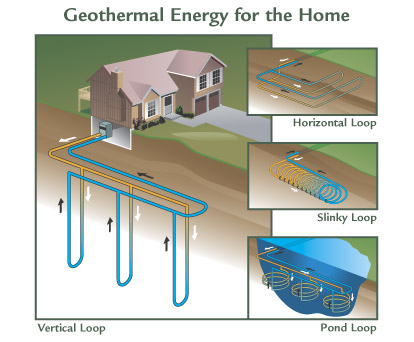As the major on-site source of geothermal energy production, a ground source heat pump provides an important source of sustainable energy for tens of thousands of buildings throughout the world.
In parts of Sweden and China, these pumps are in widespread use, heating everything from running water to central air and heating systems.
Efficient energy transfer from the ground allows these systems to actively provide an impressive source of energy that can lower energy bills by up to 50% relative to traditional fossil fuel based systems.
Most commonly, the heat pumps take the form of a ground based tube system which transfers energy, via conduction, to a home central energy system. By integrating with existing home energy regulation systems, it’s much easier to get the full set of benefits from the distribution of the energy. Many homes rely upon the heat transfer to help provide warm and hot water sources in the winter for cooking, bathing and other uses as well.
Many of the systems are up to three times more efficient than traditional methods, and this statistic is amplified even further when you factor in the effect on extreme temperature situations in very cold or warm areas.
Importantly, the ground source pumps can also provide a source of cooling when the relatively stable underground temperature is less than the hot surface. This provides an important source of cooling for hot regions such as the American South and dry parts of Asia. Studies from the Environmental Protection Agency (EPA) have documented the systems can save over 60% of a home’s energy bills during a particularly challenging climate.
This is largely the reason why agencies such as Energy Star and a variety of state governments have rebates and tax advantages for homes and businesses willing to invest in a new ground source heat pump. While making large scale adjustments to alleviate global warming and energy costs may be difficult, heat pumps are a proven source of both energy savings and sustainable natural energy transfer.
Today, there are over ½ million systems installed in the United States alone and the recent stimulus bill provided further tax incentives for home owners to green their energy systems. Estimates suggest that over 100,000 homes will begin to install these systems over the next two years, providing a further source for natural energy savings as developed countries look to reduce their reliance upon the traditional energy grid.
For areas which have particularly high energy costs, such as rural regions and those in extreme conditions, ground source heat pumps are one of the most sustainable sources of energy. As a result, many builders are now integrating heat pumps into new homes, while contractors are actively installing the system in a variety of homes and businesses.
The future growth of the sector will benefit from rebates, improving technologies and the move to modernize homes and businesses. As businesses and families seek to lower their home expenses, investing a new ground source heat pump can provide a wide variety of advantages.
If you would like to know more about how you can take advantage of using a ground source heat pump, Contact us today.

